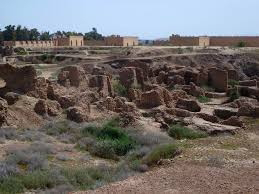The Temple of Artemis at Ephesus, also known as the Artemision , was one of the Seven Wonders of the Ancient World. It was a grand temple dedicated to the Greek goddess Artemis, the goddess of the hunt, fertility, and childbirth. The temple was located in the ancient city of Ephesus , which is now modern-day Turkey . The construction of the temple began in the 6th century BC , during the reign of King Croesus of Lydia. It was designed by the Greek architect Chersiphron and his son Metagenes . The temple was built on a marshy plain near the river Cayster, and it was raised on a platform to prevent flooding. The temple was made of marble and was adorned with sculptures and decorations. The temple was destroyed and rebuilt several times throughout history. The first temple was destroyed by a flood in 550 BC , and it was rebuilt by Croesus . The second temple was destroyed by arson in 356 BC , and it was rebuilt by Alexander the Great. The third te...
The Hanging Gardens of Babylon is one of the Seven Wonders of the Ancient World. It was a magnificent garden that was built in the ancient city of Babylon, which is now modern-day Iraq. The garden was built by King Nebuchadnezzar II, who ruled Babylon from 605 BC to 562 BC.
The Hanging Gardens of Babylon were built on a raised platform that was about 75 feet high. The platform was made of mud bricks and was supported by a series of arches. The garden was designed to look like a mountain, with terraces that rose up to the top of the platform. The terraces were supported by walls that were made of brick and stone.
The garden was filled with a variety of plants and trees, including exotic flowers, fruit trees, and vines. The plants were watered by a complex irrigation system that brought water from the nearby Euphrates River. The water was lifted to the top of the platform by a series of pumps and channels.
The Hanging Gardens of Babylon were a marvel of engineering and design. The garden was not only beautiful but also functional. The plants and trees provided shade and coolness in the hot desert climate. The garden was also a symbol of the power and wealth of the Babylonian empire.
The Hanging Gardens of Babylon were destroyed in the 2nd century BC, and their exact location is still a mystery. Some historians believe that the garden was located near the city of Hillah, while others believe that it was located in the city of Babylon itself.
Despite its destruction, the Hanging Gardens of Babylon continue to capture the imagination of people around the world. The garden has been the subject of countless works of art, literature, and film. It remains a symbol of the beauty and ingenuity of the ancient world.






Comments
Post a Comment